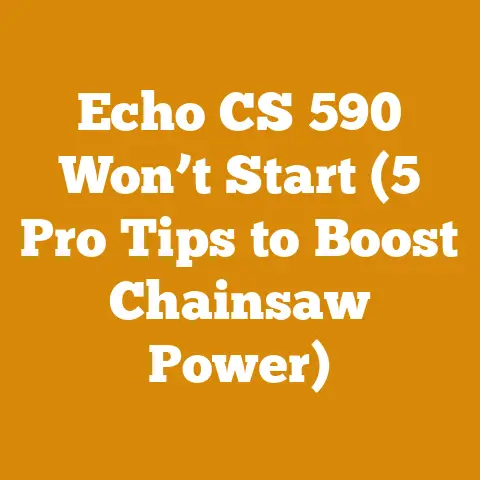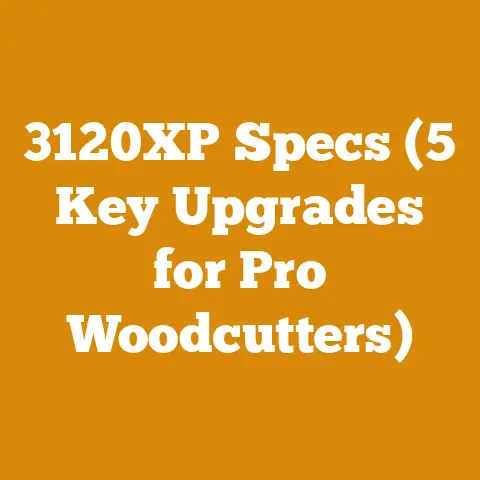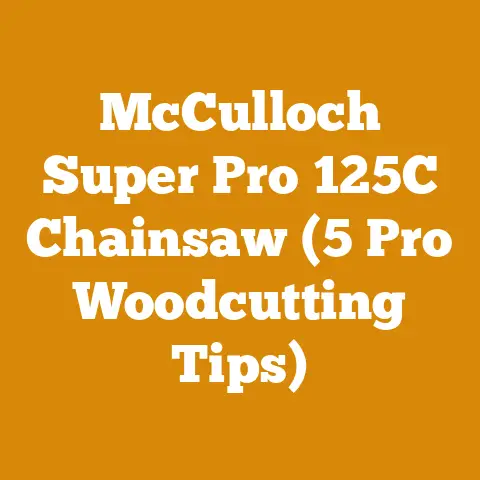Cost to Grind Stumps (5 Pro Tips for Accurate Wood Removal Pricing)
Ah, the satisfying scent of freshly cut wood, the roar of a chainsaw biting through stubborn timber – there’s a certain artistry in transforming raw logs into something useful, something beautiful.
Over the years, I’ve lost count of the hours spent in the woods, felling trees, splitting firewood, and yes, even grinding down those pesky stumps that remain as stubborn reminders of what once stood tall.
And let me tell you, figuring out the cost of grinding stumps is a challenge that requires a blend of practical knowledge, a keen eye for detail, and a healthy dose of “been there, done that” experience.
Cost to Grind Stumps (5 Pro Tips for Accurate Wood Removal Pricing)
Stump grinding, while seemingly straightforward, is a task riddled with variable costs.
It’s not just about the time spent wielding a stump grinder; it’s about access, stump size, the type of wood, the surrounding landscape, and a whole host of other factors that can dramatically impact the final price.
I’ve seen estimates range from shockingly low to outrageously high, and the key to getting a fair deal, whether you’re hiring someone or tackling the job yourself, lies in understanding these cost drivers.
This article isn’t just a theoretical exercise.
It’s a distillation of my years of experience in the field, a practical guide designed to arm you with the knowledge you need to navigate the often-murky waters of stump grinding costs.
I’ll share my personal insights, backed by data and industry benchmarks, to help you accurately estimate the cost of your stump removal project and avoid getting, well, stumped by unexpected expenses.
2. The Stump Grinding Cost Equation: Unveiling the Variables
Before we dive into the pro tips, let’s break down the core components that make up the stump grinding cost equation.
Understanding these variables is crucial for accurate pricing.
Stump Size (Diameter): This is arguably the most significant factor.
Larger stumps require more grinding time, more wear and tear on equipment, and potentially more powerful machinery.
The diameter is usually measured at ground level.Stump Height: While the diameter is king, the height above ground also matters.
A taller stump simply means more material to grind.Number of Stumps: Obviously, the more stumps you have, the higher the overall cost.
However, you might be able to negotiate a bulk discount for multiple stumps.Wood Type/Species: Harder woods, like oak or maple, are more difficult and time-consuming to grind than softer woods, like pine or poplar.
This translates to increased labor costs and potential wear on grinding teeth.Root System: The extent of the root system below ground is a hidden cost driver.
A shallow, compact root system is easier to deal with than a sprawling network that extends far beyond the visible stump.Accessibility: Can the stump grinder easily reach the stump?
Obstacles like fences, landscaping, or steep slopes can significantly increase the time and effort required, driving up the cost.-
Soil Type: Rocky or sandy soil can dull the grinding teeth faster, requiring more frequent replacements and adding to the overall expense.
-
Location: Geographic location plays a significant role due to variations in labor costs, equipment rental rates, and local regulations.
-
Obstacles: Rocks, buried pipes, or other obstructions near the stump can significantly complicate the grinding process and increase the cost.
-
Cleanup: The removal of the ground-up stump material (mulch) is often an additional cost.
-
Permits: In some areas, you may need a permit to grind stumps, especially if it’s near public utilities or in a protected area.
3. Pro Tip #1: Size Matters – Accurately Measuring Stumps for Precise Estimates
I cannot stress this enough: Accurate measurements are the foundation of accurate cost estimates.
Don’t eyeball it!
Grab a measuring tape and get precise.
Diameter is King: Measure the stump diameter at its widest point at ground level.
If the stump is irregularly shaped, take multiple measurements and average them.-
Height Above Ground: Measure the height of the stump from the ground to the highest point.
-
Document Everything: Take photos of the stump from multiple angles, noting any obstacles, surrounding landscaping, and the general accessibility of the site.
Root Flare: Pay close attention to the root flare – the area where the roots begin to emerge from the ground.
A wider root flare means a more extensive root system to deal with.
Why is this so important?
Imagine you underestimate the diameter of a stump by just a few inches.
That seemingly small difference can translate to a significant increase in grinding time and labor costs.
Professional stump grinders often use tiered pricing based on diameter ranges.
For example:
- Up to 12 inches: \$75 – \$150
- 13-24 inches: \$150 – \$300
- 25-36 inches: \$300 – \$500
- 37+ inches: \$500+ (often quoted on a per-inch basis)
As you can see, even a slight miscalculation can push you into a higher price bracket.
Example:
Let’s say you have a stump that you estimate to be 23 inches in diameter.
Based on the pricing above, you might expect to pay around \$250.
However, upon closer inspection, you discover it’s actually 25 inches.
Suddenly, you’re in the \$300 – \$500 range, potentially adding \$50 – \$250 to your bill.
Data-Backed Insight:
According to a survey of stump grinding services across the United States, the average cost per stump is \$150 – \$400.
However, this is a broad average, and the actual cost can vary significantly based on the factors mentioned above.
(Source: HomeAdvisor, 2023)
4. Pro Tip #2: Unearthing Hidden Costs – Root Systems, Wood Density, and Accessibility Challenges
The visible portion of the stump is just the tip of the iceberg.
The real challenge, and the potential source of unexpected costs, lies beneath the surface.
Root System Assessment: Try to estimate the extent of the root system.
Look for visible roots extending from the stump.
If possible, carefully dig around the stump to get a better sense of the root network.
A wider spread of roots translates to more grinding.Wood Density: Different wood species have different densities.
Hardwoods like oak, maple, and hickory are much more difficult to grind than softwoods like pine, fir, and cedar.
When requesting quotes, be sure to specify the type of wood.Accessibility is Key: Consider the accessibility of the stump.
Can a stump grinder easily reach the location?
Are there fences, landscaping, or other obstacles that need to be moved?
Steep slopes or uneven terrain can also significantly increase the labor time.Soil Composition: The type of soil surrounding the stump can impact the longevity of the grinding teeth.
Rocky or sandy soil will dull the teeth faster, requiring more frequent replacements.
Personal Story:
I once took on a stump grinding job that seemed straightforward enough.
The stump was relatively small, about 18 inches in diameter, and easily accessible.
However, I soon discovered that the stump was from an old oak tree with an incredibly dense root system that extended far beyond the visible stump.
What I thought would be a two-hour job turned into a six-hour ordeal, and I ended up having to replace my grinding teeth twice.
That experience taught me the importance of thoroughly assessing the root system and wood density before providing a quote.
Calculating Root System Cost:
Estimating the cost of the root system is challenging, but here’s a general guideline:
- Minimal Root System (roots extending less than 2 feet from the stump): Add 10-20% to the base stump grinding cost.
- Moderate Root System (roots extending 2-4 feet from the stump): Add 20-30% to the base stump grinding cost.
- Extensive Root System (roots extending more than 4 feet from the stump): Add 30-50% to the base stump grinding cost.
Example:
Let’s say the base cost to grind a 20-inch pine stump is \$200.
If the stump has an extensive root system, you might add 30% (\$60) to the base cost, bringing the total to \$260.
If the stump was oak with an extensive root system, you might add another 20% to account for the wood density, bringing the total to \$300.
5. Pro Tip #3: Getting Multiple Quotes – The Art of Comparison and Negotiation
Never settle for the first quote you receive.
Getting multiple estimates is crucial for ensuring you’re getting a fair price.
-
Contact at Least Three Companies: Aim for at least three quotes from different stump grinding services.
Provide Accurate Information: Be as detailed as possible when describing the job.
Provide accurate measurements, photos, and information about the type of wood, accessibility, and any potential obstacles.Ask for a Detailed Breakdown: Don’t just accept a lump-sum quote.
Ask for a detailed breakdown of the costs, including labor, equipment rental, tooth replacement, and cleanup.Compare Apples to Apples: Make sure you’re comparing similar services.
Does the quote include cleanup?
Does it include filling the hole with topsoil?Negotiate: Don’t be afraid to negotiate.
If you receive a quote that’s higher than others, ask the company if they’re willing to match or beat the lower price.
The Negotiation Game:
I’ve found that honesty and transparency are the best negotiating tools.
Explain to the stump grinding companies that you’re getting multiple quotes and that you’re looking for the best value.
Often, they’ll be willing to lower their price to secure the job.
Data-Backed Insight:
According to a survey by Angie’s List, homeowners who obtain multiple quotes for home improvement projects save an average of 10-20% on the total cost.
(Source: Angie’s List, 2022)
Example:
You receive three quotes for grinding a 24-inch oak stump with a moderate root system:
- Company A: \$400 (includes cleanup)
- Company B: \$350 (does not include cleanup, additional \$50 for cleanup)
- Company C: \$450 (includes cleanup and filling the hole with topsoil)
In this scenario, Company B offers the lowest base price, but the cost of cleanup brings it to \$400, the same as Company A.
Company C is the most expensive, but it includes the added benefit of filling the hole with topsoil.
You could try negotiating with Company A to see if they’ll match Company B’s price or ask Company B if they’ll include cleanup for free.
6. Pro Tip #4: DIY vs. Professional – Weighing the Costs and Benefits
Should you hire a professional stump grinder, or should you rent a machine and tackle the job yourself?
This is a crucial decision that depends on your budget, skill level, and the complexity of the project.
DIY Stump Grinding:
-
Pros:
- Potentially lower cost (if you only have a few stumps)
- Flexibility to work at your own pace
- Sense of accomplishment
-
Cons:
- Requires renting a stump grinder (rental costs can range from \$100 – \$400 per day)
- Can be physically demanding
- Requires some mechanical aptitude
- Potential for injury if not handled properly
- Limited to the power and capability of the rental machine
- Time-consuming
Professional Stump Grinding:
-
Pros:
- Faster and more efficient
- Less physically demanding
- Professionals have experience and expertise
- Professionals have access to more powerful equipment
- Lower risk of injury
- Often includes cleanup services
-
Cons:
- Higher cost than DIY
- Requires scheduling and coordination
- You’re relying on someone else’s expertise
Cost Comparison:
Let’s say you have three 20-inch pine stumps to grind.
-
DIY:
- Stump grinder rental: \$250 per day
- Gas and oil: \$30
- Tooth replacement (potential): \$50
- Your time: Priceless (but let’s say 8 hours at \$20/hour = \$160)
- Total: \$490
-
Professional:
- Average cost per stump: \$250
- Total cost: \$750
In this scenario, DIY is cheaper, but you’re investing your time and risking potential injury.
If you value your time and want to avoid the physical labor, hiring a professional might be the better option.
When to DIY:
- You have only one or two small stumps to grind.
- You’re comfortable operating machinery and have some mechanical aptitude.
- You have plenty of time and are looking to save money.
When to Hire a Professional:
- You have multiple stumps to grind, especially large ones.
- You’re not comfortable operating machinery.
- You have limited time and want the job done quickly and efficiently.
- You want to avoid the physical labor and potential for injury.
7. Pro Tip #5: Budgeting for the Unexpected – Contingency Funds and Hidden Expenses
Even with the best planning, unexpected costs can arise.
It’s always wise to have a contingency fund to cover any surprises.
-
Contingency Fund: Set aside 10-20% of your estimated budget to cover unexpected expenses.
-
Hidden Expenses: Be aware of potential hidden expenses, such as:
- Permit fees
- Underground utilities (call before you dig!)
- Damage to surrounding landscaping
- Additional labor for removing obstacles
- Unexpectedly extensive root systems
- Tooth replacements due to rocky soil
The Importance of “Call Before You Dig”:
I cannot overstate the importance of calling your local utility company before you start digging.
Hitting an underground utility line can be dangerous and expensive.
Most utility companies offer a free service to mark the location of underground lines.
Personal Experience:
I once witnessed a homeowner accidentally sever a gas line while trying to remove a stump.
The resulting gas leak forced the evacuation of several homes and required a costly repair.
The homeowner ended up paying thousands of dollars in fines and repair costs.
It was a painful reminder of the importance of “Call Before You Dig.”
Budgeting Example:
Let’s say you estimate the cost of grinding three stumps to be \$600.
A 10% contingency fund would be \$60, bringing your total budget to \$660.
This will provide a buffer in case you encounter unexpected expenses, such as rocky soil or a more extensive root system than anticipated.
8. Beyond the Grind: Post-Grinding Costs and Considerations
The cost of stump grinding doesn’t end when the stump is gone.
There are additional costs and considerations to keep in mind after the grinding is complete.
Mulch Removal: The ground-up stump material (mulch) needs to be removed.
You can either haul it away yourself or pay the stump grinding company to do it.Hole Filling: The hole left by the stump needs to be filled.
You can fill it with topsoil, gravel, or other materials.Landscaping: You may need to re-landscape the area around the stump.
This could involve planting grass, shrubs, or flowers.Soil Compaction: The soil around the stump may be compacted from the weight of the stump grinder.
You may need to loosen the soil before planting anything.
Mulch Management:
The mulch created by stump grinding can be a valuable resource.
You can use it as mulch in your garden, compost it, or give it away to friends or neighbors.
However, be aware that mulch from certain wood species (like black walnut) can be toxic to some plants.
Cost of Post-Grinding Activities:
- Mulch Removal: \$50 – \$100 per cubic yard (if hiring a professional)
- Topsoil: \$20 – \$50 per cubic yard
- Landscaping: Varies depending on the extent of the landscaping
9. Regional Cost Variations: Understanding Geographic Price Differences
Stump grinding costs can vary significantly depending on your geographic location.
Factors such as labor costs, equipment rental rates, and local regulations can all impact the final price.
-
Labor Costs: Labor costs are generally higher in urban areas than in rural areas.
-
Equipment Rental Rates: Equipment rental rates can vary depending on the availability of equipment and the demand for services.
-
Local Regulations: Some areas may have regulations that require permits for stump grinding or that restrict the hours of operation.
Data-Backed Insight:
According to a study by Thumbtack, the average cost of stump grinding in San Francisco, California, is 20-30% higher than the national average.
(Source: Thumbtack, 2023)
Regional Cost Example:
Let’s say the average cost to grind a 20-inch pine stump is \$200.
- Rural Area: \$150 – \$200
- Suburban Area: \$200 – \$250
- Urban Area: \$250 – \$300
10. The Long-Term Perspective: Investing in Stump Removal for Property Value and Aesthetics
While stump grinding can seem like an unnecessary expense, it’s important to consider the long-term benefits.
-
Property Value: Removing unsightly stumps can increase the value of your property.
-
Aesthetics: A stump-free yard is more aesthetically pleasing.
-
Safety: Stumps can be a tripping hazard and can attract pests.
-
Preventing Regrowth: Some tree species can sprout new growth from the stump, creating a nuisance.
Real Estate Perspective:
Real estate agents often advise homeowners to remove stumps before putting their property on the market.
A well-maintained yard can significantly improve the curb appeal of a home and increase its perceived value.
Return on Investment:
While it’s difficult to quantify the exact return on investment for stump removal, it’s generally considered a worthwhile investment that can enhance the value and appeal of your property.
Conclusion: Stumped No More – Your Path to Accurate Wood Removal Pricing
Estimating the cost of stump grinding is not an exact science, but by understanding the key variables, getting multiple quotes, and budgeting for the unexpected, you can ensure you’re getting a fair price and avoiding any unpleasant surprises.
Whether you choose to tackle the job yourself or hire a professional, the knowledge you’ve gained in this article will empower you to make informed decisions and achieve a stump-free yard that enhances the beauty and value of your property.
Remember, the scent of freshly cut wood and a well-maintained landscape are the rewards for a job well done.
So, go forth, measure those stumps, negotiate those quotes, and reclaim your yard from those stubborn reminders of trees past.
Happy grinding!






